"We're back baby !" for our second update after two weeks since the last project log.
Things are real fine, we actually received most of the components we needed and were able to get to work on both hardware and software sides and so we were able to code the things we needed to configure minidlna quite easily and post a build instruction about it.
"1.21 gigawatts of electricity !" [Dr. Emmett L. Brown]
Last week, we took a day to go to the local store in order to prepare a good power cable for the power supply. We used a flat plug with a little hook to unplug it and a foot-triggered switch. This won't looks really futuristic but hey! if you have seen "THX1138", you know that white IS futuristic! Quickly, we got into testing and adjust the power supply.
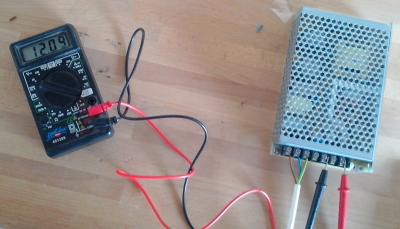
Adjusting the power supply
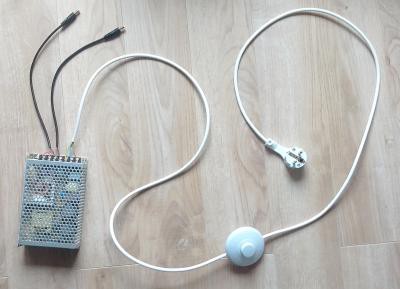
THX1138 style cable
The Cable guys
As the jack dispenser needs jack connectors we also started the soldering part. So now our 5 female jacks are ready to be plugged on the little amp we are about to receive. We soldered one of our ø6,5mm female jack to ø3,5mm male jack for auxiliary sound input using an old audio cable for stereo. The last four of them are soldered on mono audio cable. Since the female jacks are stereo, we needed to solder it in a way it would act as a mono. We came up with this cabling:
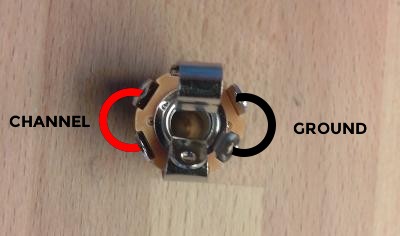
Mono cabling
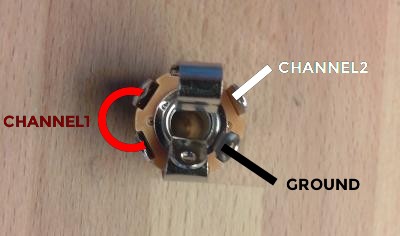
Stereo cabling
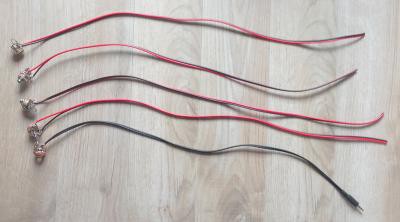
The cables we made
The cables were tested with an adapter and plugged to a laptop. It worked perfectly as we planned.
Thinking gave us a headache
The plasma ball has also been disassembled to see how it could fit in the whole structure. We also tried, with success, to add a longer wire to the plasma ball for when we will fit it in the Jack Dispenser. There is some kind of metal scrap inside the plasma ball and the wire should touch it in order to make a good electrode.
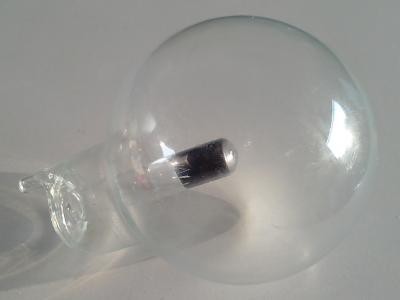
For the same concerns we made a 3D model of a tiny 3 floor wooden structure that will be placed in the lower part of the jack dispenser. The advantage of this little structure is that it will ballast the object so we can easily open it without worrying it would fall. Opening the jack dispenser will probably be done with hinges, by leaning the upper part like you would do with a treasure chest. The floors will be held with leadscrews and nuts. It is as simple as it could be and we should be able to get it in or out easily for maintenance.
Here is a quick model of our structure. We will probably update it as soon as it evolves.

Getting the sound
Besides all the functions we can find in the amplifier (SD card, USB, aux input, FM/AM etc...), we felt like we needed a more modern way to play our music. We found a USB dongle that was lost on a previous project and decided to search a way to stream music from any devices without dragging kilometers of cables or having to install complex software.
After a few experiments with different media streaming systems, we choose to get our hand on the DLNA protocol which is widely used by a lot of (not so) smart TV and media devices. The DLNA protocol (in a media streaming context, forget about DLNA printers), allows a device to be one of the three kinds of these devices:
- DLNA Server: this device can stream media over the network
- DLNA Renderer: this device render the media (plays sound on headphones or video on screen)
- DLNA Controller: this device act as a controller, it can tell from which server the renderer should get its stream and is able to pause/play it or make playlists
We came up with minidlna which is a common software you can find in any good Operating System. Minidlna acts as a DLNA Server. With it, you should be able to read media contained in an external hard disk or in the SD card of the Raspberry Pi, on a DLNA Renderer such as your TV or your cellphone.
In order to add DLNA rendering to our Jack Dispenser, we used gmrender-resurrect which is a not so easy to find software. Luckily, it was available in the Arch Linux AUR (user repository full of scripts to build packages). It works natively with Alsa and enables the user to send music to the Raspberry and hear it coming from the Jack Dispenser. All the rendering tests went actually so fine pierrep decided to use personnaly miniDLNA and a gmrender-resurrect to use his cellphone as a remote for all medias played on his computer. No lag happened to show up while any of the tests and use no we can now tell miniDLNA perfectly matched the intended software purposes of the project.
What do we plan ?
We had some though about adding a switch to the raspberry to enable a kind of hotspot connexion. This connexion will be useful in case there would be no WiFi available. The user will be able to connect onto our Jack Dispenser and stream the sound regardless the lack of connectivity as long as he stays around. More than that we though of creating a WebUI that will enable the user to control the WiFi hotspot and save SSID and password in order to autoconnect when a wifi network is detected and when the Raspberry isn't in hotspot mode.
After receiving the amplifier, we will start building the Jack Dispenser and try to make a quick demo of the basic fonctionning, how to open it et cetera. Don't miss it!
Note: we're trying to make this project as fast as we can but we can't be shipped faster than the delivery boy can run. Plus, we are working all day and have others activities beside making fun projects (pierrep is playing in a band, go listen to the (badly recorded) great songs on Soundcloud, next time you will here it, it will be on a Jack Dispenser!). Please stay tune for (not so) badass sound!
 pierrep
pierrep
Discussions
Become a Hackaday.io Member
Create an account to leave a comment. Already have an account? Log In.